What opportunities does the right to vote provide?
Up until the Civil War, in most places, the right to vote in the United State was restricted to white males 21 years and older. Each state, not the federal government, established its own voter qualifications, but by far, adult white males accounted for almost all of the ballots cast. In the Dred Scott decision in 1857, the U.S. Supreme Court ruled that enslaved people were property of their owners, were not citizens and had no legal rights at all. A decade later, African Americans were not only free, but they were free citizens, and in Iowa, the path had been set to grant them the right to vote.
African-American Suffrage
The first two constitutions adopted by the people of Iowa limited the suffrage (right to vote) to white males 21 years and older. While slavery might have been illegal in Iowa, many state laws discriminated against African-American residents. The "black codes" that required African Americans to post financial bonds to live here and denied them the right to serve on juries were designed to discourage them from migrating to Iowa. A strong majority in the state opposed intermarriage between whites and African Americans and held that African Americans were not as intelligent as whites.
The Civil War began to reshape white attitudes toward African Americans. Iowa soldiers fighting in the South saw first-hand the evils of slavery. Freeing slaves where the Union Army took control weakened the strength of the Confederate Army. Furthermore, after the southern surrender, the Republican Party was eager to grant African Americans the right to vote because they anticipated their votes would be strongly Republican, the party of Abraham Lincoln and the opponents of their former masters.
At the behest of Alexander Clark, an African American and Iowan who fought in the Civil War, Iowa voters (entirely white males) went to the polls and approved a constitutional amendment striking the word "white" from voting requirements in 1868. A man, African American or white, could vote in Iowa if he was 21 years old and a resident. At the same time, the 15th Amendment to the U.S. Constitution forbade any state from denying the vote to anyone on the basis of race, color or previous condition of servitude (slavery). Until the Great Depression in the 1930s, African Americans tended to adhere to the Republicans who had fought to end slavery and grant them their freedom. New Deal programs that provided direct relief to the desperately poor, which included both whites and African Americans, won over many African-American voters to the Democrats.
Women's Suffrage
While African-American males were winning the right to vote, advocates for women's suffrage saw an opportunity to advance their cause. In 1848, a convention at Seneca Falls, New York, was the first to call for granting the right to vote to women, but the issue gathered little support before the Civil War. Because suffrage requirements were written into the Iowa constitution, any change required a proposal to be passed in two consecutive legislative sessions and then submitted to the voters for approval. While a women’s suffrage bill could sometimes pass the House or the Senate in one session, it could never win approval by both chambers for two sessions.
Powerful opponents lined up against granting the vote to women. Most prominent were those who opposed prohibition, a strict limitation on the manufacture and sale of liquor. It was assumed that women voters would be hostile to liquor interests and would support greater restrictions. European immigrant groups, especially Germans and Irish, had no traditions that saw drinking as evil. Conservative churches, including Catholics, opposed women's suffrage as an attack on traditional family values. They pointed to Bible instructions that the man was to be the head of the house and that the wife was to submit to his authority. Women's suffrage made the two equal, and, some argued, could lead to friction within the family. In communities along the Mississippi and in northeast Iowa with strong Irish and German communities, there was strong opposition to votes for women. In western Iowa where Protestant churches like the Baptists, Methodists and Presbyterians dominated, there was strong support for both prohibition and women's suffrage.
Carrie Chapman Catt, who was raised in Iowa, rose to the head of a national association promoting women's suffrage. Early victories in several western states led women's advocates that they could soon gain the right to vote across the nation, but it remained a tough battle. Around the turn of the century, women were allowed to vote on referenda like bond issues, but not in "elections" where there are candidates. This was known as the partial suffrage. In 1916, Iowa votes (still all male) narrowly defeated a women’s suffrage amendment that would have struck the word "male" from the state’s voting requirements. Nevertheless, when Congress submitted the 19th amendment to the U.S. Constitution to the states for ratification, the Iowa legislature approved it. In the 1920 elections, women across the United States went to the polls. Later in the decade, Iowa women won the right to serve on juries and be elected to public office.
American-Indian Suffrage
American Indians had a long and complex legal status within the United States. The tribes were considered sovereign nations and the federal government signed treaties with them just as if they were foreign powers. In most cases, American Indians could not vote unless they left their tribes and lived in white communities. During World War I, many American Indians served with distinction in the armed forces. In recognition to their service, the U.S. Congress passed the Snyder Act, which granted full citizenship to American Indians whether they remained on tribal lands or moved into mainstream society.
The 26th Amendment to the U.S. Constitution was ratified in 1971. It expanded the right to vote in federal elections to citizens 18 years and older, lowering the legal voting age from 21. Each state had to approve it for state and local elections.
The number of legal voters has expanded widely since the U.S. Constitution was adopted. Voting is the most basic right of each citizen, and who gets the right to cast a ballot for elected leaders has been a contentious issue. Today, there is a debate over whether those who have committed a felony should have the vote, even after they have served their time. Other issues may still surface.
Supporting Questions
How did African Americans obtain the right to vote?
- "First Vote" Illustration, November 16, 1867 (Image)
- Alexander Clark’s Speech at the "Colored Convention" in Des Moines, Iowa, 1868 (Document)
- Portrait of Governor William M. Stone, 1868 (Image)
- 15th Amendment to the U.S. Constitution, February 27, 1869 (Document)
- "The Fifteenth Amendment," 1870 (Image)
- Distribution of the Colored Population of the United States in 1890, 1898 (Map)
- Voter Registration Literacy Test in Alabama, 1964 (Document)
- African-American Demonstrators Outside the White House, March 12, 1965 (Image)
- Oral History Interview with African-American Politician Robert G. Clark, Jr., in Pickens, Mississippi, March 13, 2013 (Video)
- Oral History Interview with African-American Activist Charles Siler about Life in Louisiana, May 10, 2013 (Video)
How did women obtain the right to vote?
- Women's Suffrage Parade Shown Passing by Church, October 29, 1908 (Image)
- "Votes for Women! The Woman's Reason" by the National American Woman Suffrage Association, 1912 (Document)
- Billboard Urging Iowans to Vote "Yes" for Women's Suffrage, 1916 (Image)
- Map Abstract of June 5, 1916, Vote for Woman Suffrage Constitutional Amendment in Iowa, 1916 (Map)
- Route of Envoys Sent by the Congressional Union for Woman's Suffrage to Organize in the West, between April and May 1916 (Map)
- Anti-Suffrage Ad from The Iowa Homestead, May 25, 1916 (Document)
- Letter from Anna Lawther of the Iowa Equal Suffrage Association to County Chairs, November 13, 1918 (Document)
- Activists Leaving National Woman's Party Headquarters to Take Petition to Senator Jones of New Mexico, 1918 (Image)
- Letter from President Woodrow Wilson to Carrie Chapman Catt, June 7, 1918 (Document)
- Response Letter from Iowa Secretary of State W.S. Allen to Anna Lawther, December 1918 (Document)
- 19th Amendment to the U.S. Constitution, August 26, 1920 (Document)
- Sculpture of Lucretia Mott, Elizabeth Cady Stanton and Susan B. Anthony, between 1921 and 1923 (Image)
How did American Indians obtain the right to vote?
- Sac and Fox Treaty, 1842 (Document)
- Iowa Law to "Allow Meskwaki to Purchase Land and Live in Tama, Iowa," July 15, 1856 (Document)
- Meskwaki Proclamation Day Brochure: "Old Indian Town," July 13, 1857 (Document)
- Sac and Fox Treaty, 1867 (Document)
- Motion Presented by Iowa Senator J.B. Grinnell, February 5, 1867 (Document)
- "Move On!" Political Cartoon, April 22, 1871 (Political Cartoon)
- Citizenship Act, June 2, 1924 (Document)
- President Calvin Coolidge Posing with American Indians at White House, February 18, 1925 (Image)
- "Political Rights from Citizenship” in The Problem of Indian Administration, February 21, 1928 (Document)
- Constitution and Bylaws of the Sac and Fox Tribes in Iowa, December 29, 1937 (Document)
- Oral History Interview with Henry Mitchell, an American Indian Canoe Maker, 1938 (Document)
- Civil Rights Act of 1957, September 9, 1957 (Document)
- Voting Rights Act, 1965 (Document)
- Meskwaki Land Purchases, 2004 (Map)
“Political Rights from Citizenship” in The Problem of Indian Administration, February 21, 1928
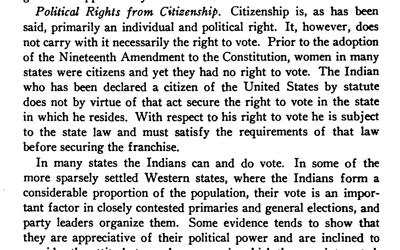
Description
"The Problem of Indian Administration" report was created by a group of 10 staff members who spent seven months gathering information about the social and economic status of American Indians throughout the country. This 872-page report, also known as the Meriam Report,…
Constitution and Bylaws of the Sac and Fox Tribes in Iowa, December 20, 1937
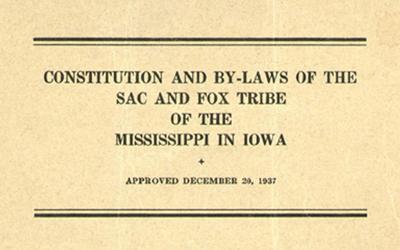
Description
After the U.S. Congress created the Indian Reorganization Act of 1934, the Meskwaki established their own constitution. This document is the constitution and its by-laws as it was created in 1937. The preamble states, "We, the Mesquakie Indians, enrolled members of the Sac…
Oral History Interview with Henry Mitchell, an American Indian Canoe Maker, 1938
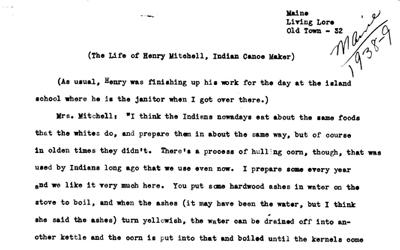
Description
This oral interview of Henry Mitchell and his wife, American Indians in Maine, was completed by Robert Grady with the Federal Writers’ Project in 1938. Henry Mitchell was a professional canoe maker and talks about the beliefs and customs he grew up with along with…
Iowa Law to "Allow Meskwaki to Purchase Land and Live in Tama, Iowa," July 15, 1856
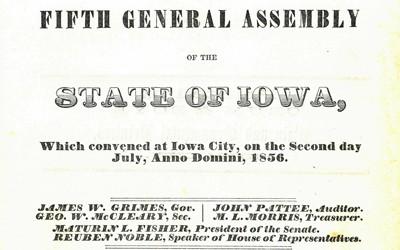
Description
This is an excerpt of the journal from the 5th General Assembly of Iowa in 1856. The journal page shows the law that was enacted so the Meskwaki could purchase land and live in Tama, Iowa.
Civil Rights Act of 1957, September 9, 1957
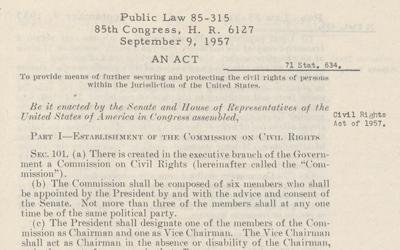
Description
This legislation established a Commission on Civil Rights to investigate civil rights violations and also established a Civil Rights Division within the Department of Justice. The Civil Rights Act of 1957 authorized the prosecution for those who violated the right to…
Sac and Fox Treaty, 1842
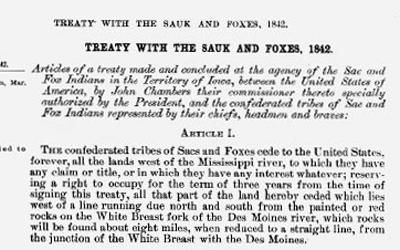
Description
The introduction reads, "articles of a treaty made and concluded at the agency of the Sac and Fox Indians in the Territory of Iowa, between the United States of America, by John Chambers their commissioner thereto specially authorized by the President, and the…
Meskwaki Proclamation Day Brochure: "Old Indian Town," July 13, 1857

Description
As printed in "Proclamation Day Brochure," a publication of the Meskwaki tribe to commemorate those who defied orders to relocate to "Indian Territory" and remained in Iowa, the brochure tells the laws, treaties, resolutions and official statements on the relocation…
Meskwaki Land Purchases, 2004
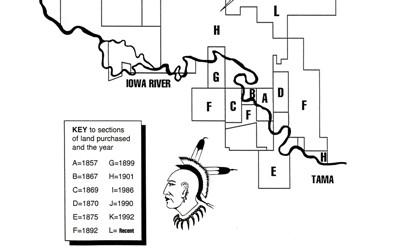
Description
This map and accompanying text show the history of land purchases made by the Meskwaki tribe. This particular political map shows the dates of multiple land purchases around Highway 30 and the Iowa River by the Meskwaki tribe from 1857 to recent years.
Sac and Fox Treaty, 1867
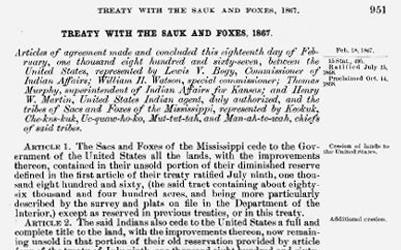
Description
In this 1867 treaty, the Sac and Fox tribes agreed to purchase 750,000 square miles of land in portions of what is now Payne, Lincoln and Pottawatomie counties. The introduction states: "Articles of agreement made and concluded this eighteenth day of February, one…
Citizenship Act, June 2, 1924
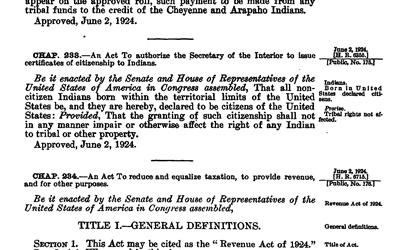
Description
This 1924 act by Congress granted citizenship to all American Indians born in the United States. However, the right to vote was governed by state law. Until 1957, some states barred American Indians from voting.
Motion Presented by Iowa Senator J.B. Grinnell, February 5, 1867
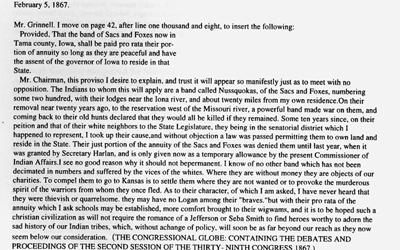
Description
This document summarizes the motion made by United States Senator J.B. Grinnell from Iowa to an appropriations bill being debated in the U. S. Senate on February 5, 1867. Grinnell’s request was to insert text to allow the band of Sacs and Foxes, who would later…
Voting Rights Act, 1965
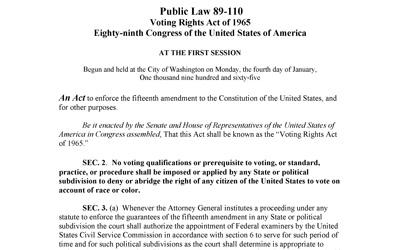
Description
This act was signed into law on August 6, 1965, by President Lyndon B. Johnson. It outlawed the discriminatory voting practices adopted in many southern states after the Civil War, including literacy tests as a prerequisite to voting. This was a landmark piece of…
"The First Vote" Illustration, November 16, 1867
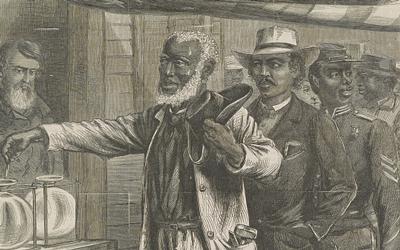
Description
This illustration shows African-American men in outfits indicative of their professions standing in a line waiting for their turn to vote. The text belong the image reads, "The First Vote." This print was published in Harper's Weekly on November 16,…
Alexander Clark’s Speech at the "Colored Convention" in Des Moines, Iowa, 1868
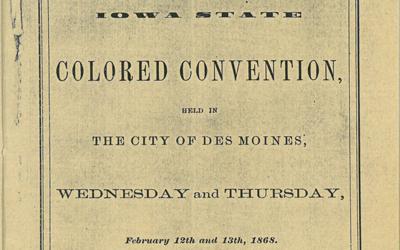
Description
Alexander Clark, an African-American barber turned lawyer from Muscatine, became a hero of African-American rights in the state of Iowa. In this address to the "Colored Convention" in Des Moines, Clark calls for the Iowa Legislature to approve and then place before the…
Portrait of Governor William M. Stone, 1868
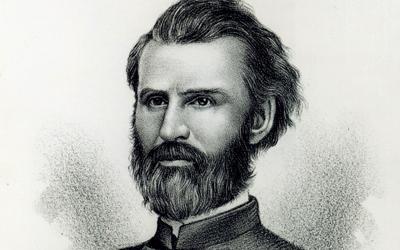
Description
This portrait is of William M. Stone, who would serve as Iowa's Republican governor during the end of the Civil War. Before being elected, he was a decorated officer in the Union Army, and at one point, had been a prisoner of war during the Civil War. Stone also was a…
15th Amendment to the U.S. Constitution, February 27, 1869
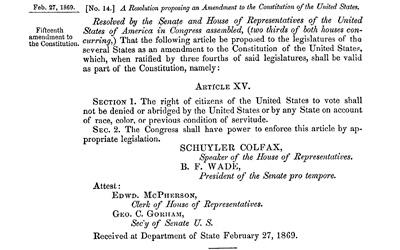
Description
The 15th Amendment to the U.S. Constitution was ratified on February 3, 1870, and prohibited federal and state governments from denying any citizen the right to vote based on that person's "race, color or previous condition of servitude." The amendment was important in…
"The Fifteenth Amendment," 1870
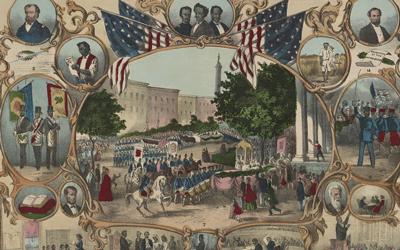
Description
This print shows a parade surrounded by portraits and vignettes of African-American life, illustrating rights granted by the 15th Amendment.
Distribution of the Colored Population of the United States in 1890,1898
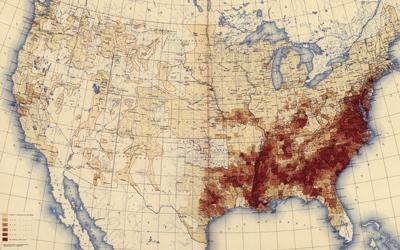
Description
A statistical atlas of the United States that is based on the results of the 11th census, completed in 1890, shows the distribution of the "colored population" of the country. As can be seen in the distribution map, members of the targeted population predominantly…
Voter Registration Literacy Test in Alabama, 1964
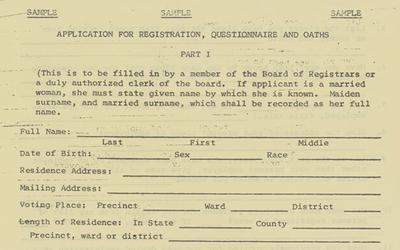
Download Resource Download Resource
Description
After the Civil War, many states enacted literacy tests as a voting requirement. The purpose was to exclude persons with minimal literacy, in particular, poor African Americans in the South, from voting. This was achieved by asking these prospective voters to interpret…
African-American Demonstrators Outside the White House, March 12, 1965
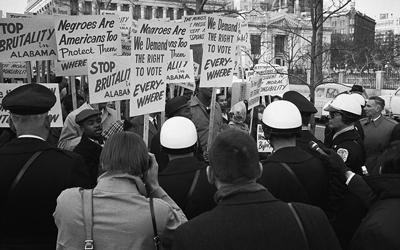
Description
This photograph by Warren Leffler shows African-American demonstrators outside the White House, with signs reading "We demand the right to vote, everywhere" and protesting police brutality against civil rights demonstrators in Selma, Alabama. On August 6, 1965, U.S.…
Oral History Interview with African-American Politician Robert G. Clark, Jr., in Pickens, Mississippi, March 13, 2013
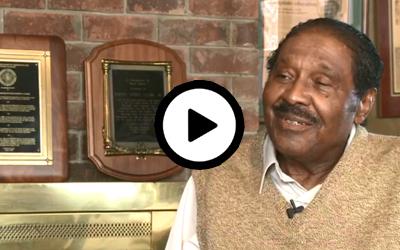
Description
Robert G. Clark, Jr., describes the early life experiences that led up to his successful campaign for political office in the Mississippi legislature, where he became the first African American elected since Reconstruction. Clark discusses his career as an educator,…
Oral History Interview with African-American Activist Charles Siler about Life in Louisiana, May 10, 2013
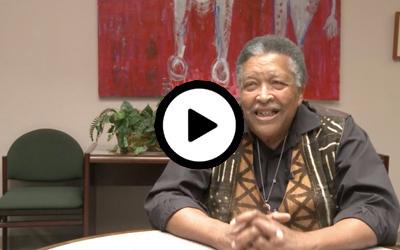
Description
Charles Siler remembers his early life in Louisiana, including a penchant for drawing that began before the age of two, quitting the Boy Scouts when his troop made black Scouts walk behind the horses in a local parade, and picketing Louisiana's segregated state…
Women’s Suffrage Parade Shown Passing by Church, October 29, 1908
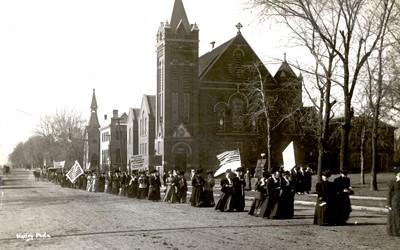
Description
In this photograph, taken in Boone, Iowa on October 29, 1908, a suffrage parade made up of people carrying banners and flags passes by a large church. One banner held by a parade marcher reads: “Taxation Without Representation Is Tyranny. As True Now As In 1776.”
“Votes for Women! The Woman's Reason" by the National American Woman Suffrage Association, 1912
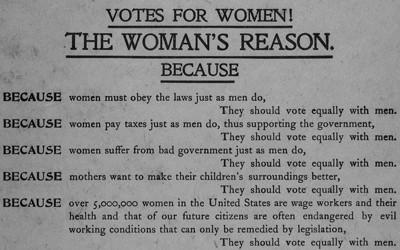
Description
The broadside, published by the National American Woman Suffrage Association, includes 10 reasons why women should vote equally with men are listed. The poster was created in 1912, and even made reference to a line made famous by Abraham Lincoln's second inaugural…
Billboard Urging Iowans to Vote "Yes" for Women's Suffrage, 1916
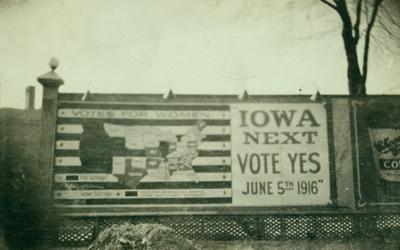
Description
This photograph is of a billboard urging Iowans to "vote yes" to add a women's suffrage amendment to the Iowa Constitution on June 5, 1916. The large text reads, "Iowa Next. Vote yes June 5th 1916," and is next to a map of the 48 contiguous states. The states where "full…
Map Abstract of June 5, 1916, Vote for Woman Suffrage Constitutional Amendment in Iowa, 1916
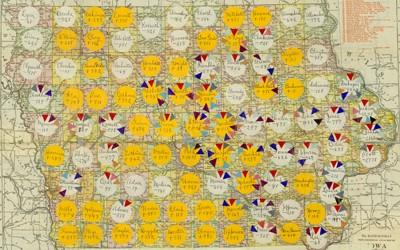
Description
This 1916 map from Carrie Chapman Catt’s scrapbook was created after the failed June 5, 1916, vote attempt to add a woman suffrage amendment to the Iowa constitution. Suffragists plotted out the margin of victory or loss by county. Their work also included the 12…
Route of Envoys Sent by the Congressional Union for Woman's Suffrage to Organize in the West, between April and May 1916
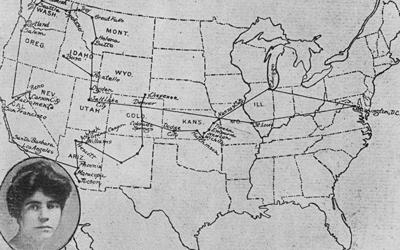
Description
This map of the United States shows the tour of Congressional Union for Woman Suffrage as they travel to the West to recruit and organize fellow women suffragists. An image of suffragist Alice Paul is in the lower left-hand corner. The map is captioned "Call to Women…
Anti-Suffrage Ad from The Iowa Homestead, May 25, 1916

Description
This advertisement, printed in The Iowa Homestead on May 25, 1916, was funded by the Iowa Association Opposed to Woman Suffrage. The organization argues that women's suffrage would directly lead to both higher taxes and…
Letter from Anna Lawther of the Iowa Equal Suffrage Association to County Chairman, November 13, 1918
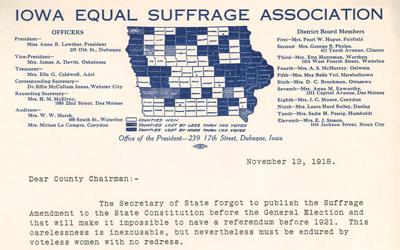
Download Resource Download Resource
Description
In a letter to a county chairman, Anna Lawther states that the secretary of state forgot to publish the suffrage amendment in newspapers prior to the June 5 election which led to the amendment’s defeat. She urges the chairman to write their state and federal…
Activists Leaving National Woman's Party Headquarters to Take Petition to Senator Jones of New Mexico, 1918
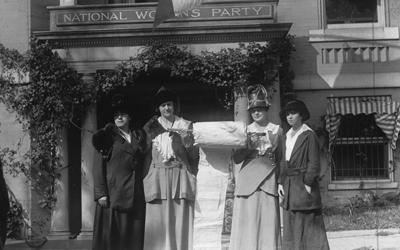
Description
This photograph shows Annie Fraher, Bertha Moller, Berthe Arnold and Anita Pollitzer standing outside the National Woman's Party headquarters with a large-rolled suffrage petition. After a multi-state journey, the petition was delivered to Senator Andrieus Jones of New…
Letter from President Woodrow Wilson to Carrie Chapman Catt, June 7, 1918

Description
President Woodrow Wilson said in this letter to Carrie Chapman Catt that he believes democracy will not have reached its fullest until women are given the right to vote. He also said he fully supported women’s suffrage and acknowledged the significant contributions that…
Response Letter from Iowa Secretary of State W.S. Allen to Anna Lawther, December 1918
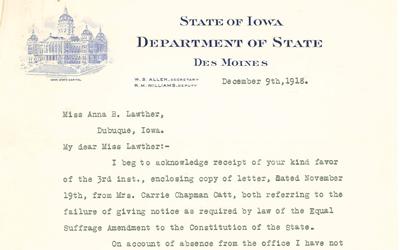
Description
Iowa Secretary of State W. S. Allen wrote this response letter to Anna Lawther and Carrie Chapman Catt to apologize for not publishing the proposed suffrage amendment in local newspapers ahead of the June 5, 1916, vote. He insisted that it was an unfortunate mistake…
19th Amendment to the U.S. Constitution, August 26, 1920
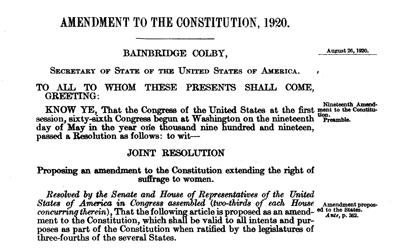
Description
The United States Congress approved a women’s suffrage amendment to the U.S. Constitution and three-fourths of the states ratified it. On August 26, 1920, Secretary of State Bainbridge Colby officially certified the 19th Amendment with his signature and the seal of…
Sculpture of Lucretia Mott, Elizabeth Cady Stanton and Susan B. Anthony, between 1921 and 1923
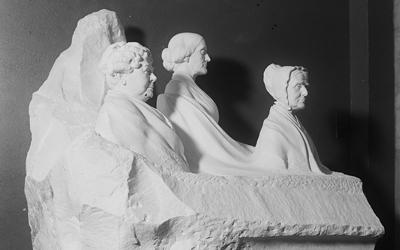
Description
On February 15, 1921, representatives of over 70 women’s organizations gathered at the United States Capitol Rotunda for the unveiling ceremony of this monument featuring prominent leaders of the women’s suffrage movement. Left to right, the figures represent: Elizabeth Cady…
"Move On!" Political Cartoon, April 22, 1871
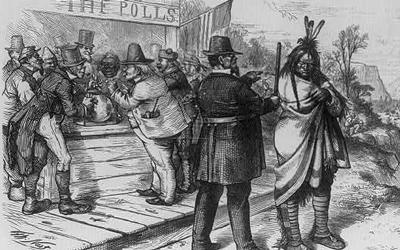
Description
In this political cartoon appearing in Harper's Weekly on April 22, 1871, a policeman is seen ordering an American Indian man to "move on" away from a voting poll where other stereotyped "naturalized" Americans are clustered.
President Calvin Coolidge Posing with American Indians at White House, February 18, 1925
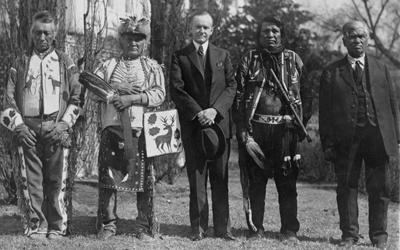
Description
President Calvin Coolidge posed with American Indians, possibly from the plateau area in the northwestern United States, near the south lawn of the White House on February 18, 1925. In June of 1924, Congress passed The Citizenship Act of 1924, granting citizenship to all…
Additional Resources
African-American Suffrage:
- Jim Crow and Segregation Primary Source Set
This Library of Congress online resource contains classroom material about the use of Jim Crow laws to oppress African Americans in the south and segregation throughout the United States. - 15th Amendment to the U.S. Constitution
This Library of Congress web guide provides an overview of the 15th Amendment and its impact on African American men who were granted the right to vote. - Oral History Interview with Rosie Head
In this video interview, Rosie Head describes her early life in Greenwood, Mississippi, where her family lived and worked on a plantation. She discusses how her parents faced racial discrimination in their work and how they were cheated by the plantation owner and then blacklisted. In 1964, Head joined the Civil Rights Movement in Tchula, Mississippi, and she recounts the various ways she was involved in the movement: registering voters, working with Freedom Summer volunteers, helping to establish the Child Development Group of Mississippi and campaigning for black candidates for political office. - "The Negro Suffrage Issue" Essay from The Annals of Iowa
This essay by G. Galin Berrier in 1968 looks at the African-American suffrage movement after the Civil War between 1865 to 1868.
Women’s Suffrage:
- Iowa Women's Suffrage Collection
To celebrate the centennial of the 19th Amendment, the State Historical Society of Iowa has shared photographs and documents from the Iowa Women's Suffrage Collection. - "Women's Suffrage in Iowa"
This online exhibit features women's suffrage resources from the Iowa Women’s Archives and State Historical Society of Iowa. - Interview with Carrie Chapman Catt
This short video features prominent suffragist leader, Carrie Chapman Catt, who was born and raised in Iowa. - Carrie Chapman Catt's Address to the U.S. Congress
This website for the Carrie Chapman Catt Museum in Charles City, Iowa, includes text of a speech Catt gave to to the U.S. Congress in 1917 on the inevitability of women's suffrage. - "The Fight for Women’s Suffrage" from IPTV
This online webpage from Iowa Public Television's "Iowa Pathways" collection summarizes the history of women’s suffrage in Iowa. - Trial of Susan B. Anthony
This online resource from UMKC School of Law summarizes the trial of women's suffragist leader Susan B. Anthony after she illegally voted in Rochester, New York in 1872.
American-Indian Suffrage:
- Congress Granted Citizenship to All American Indians
This website includes a three-part timeline on legislation to grant citizenship to American Indians born in the United States. - Indian Citizenship Act
This day in history feature from the Library of Congress summarizes the passage of the Indian Citizenship Act on June 2, 1924. - Civil Rights Act of 1957
This webpage from govtrack.us contains infographics and summaries of the record of the U.S. Senate’s vote on the Civil Rights Act of 1957. - Voting Rights for American Indians
This Library of Congress webpage contains an article and photos that summarizes the struggle American Indians faced in the process of being granted voting rights in America. - Toledo Indian Industrial School
These two photographs from the State Historical Society of Iowa the school building, students and staff of the Toledo Indian Industrial School near Tama, Iowa.
Iowa Core Social Studies Standards (5th Grade)
Listed below are the Iowa Core Social Studies content anchor standards that are best reflected in this source set. The content standards applied to this set are high school-age level and encompass the key disciplines that make up social studies for fifth-grade students.
| No. | Standard Description |
| SS.5.8. | Analyze how rights and laws influence interactions between groups in society. |
| SS.5.10. | Describe how the Declaration of Independence and the Constitution impact the decisions of government, society, and/or communities. |
| SS.5.12. | Describe how laws, rules and processes have changed over time in order to restrict, protect, or extend rights. |
| SS.5.21. | Describe the connections between historical developments that occurred within the same time period. |
| SS.5.22. | Explain how economic, political, and social contexts shaped people's perspectives at a given time in history. |
| SS.5.23. | Using information from within a primary source, infer the intended audience, purpose, and how the creator's intended audience shaped the source |
| SS.5.26. | Analyze Iowa's role in civil rights history. |